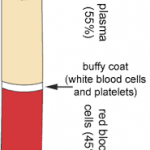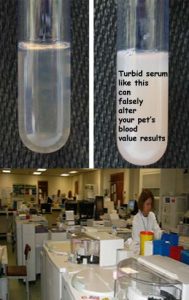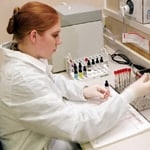Ron Hines DVM PhD
 See What Normal Blood & Urine Values Are
See What Normal Blood & Urine Values Are
 Causes Of Most Abnormal Blood & Urine Tests
Causes Of Most Abnormal Blood & Urine Tests
Turbidity = Cloudiness In Your Pet’s Blood Serum Sample
Some clinical chemists and diagnostic laboratories do not differentiate between the cloudiness of blood serum samples that contain large amounts of tiny fat droplets (a lipemic sample) and those that contain tiny grains of other non-fatty material that make the straw-colored liquid appear cloudy (turbid). I was taught that the two are not the same. If you or your veterinarian consider them to be the same, read about the sources and causes of lipemia in blood samples here and add them to this explanation and list of causes of turbidity.
When your veterinarian takes a sample of your dog or cat’s blood to run laboratory tests, the blood constituents that compose it stratify. The lower, heavier layer consists of your pet’s red and white blood cells. After the test tube containing the blood is centrifuged or allowed to settle, that portion is removed and discarded. The upper liquid portion (the serum) should be pale yellow and clear. 
Turbidity and lipemia are both important because they can alter many of your dog or cat’s blood chemistry test values. (read here) Many of the machines used to record blood chemistry values depend upon the amount of light that passes through your pet’s serum sample after chemicals have been added (absorbency readings). Particles that form turbidity or the tiny globules of fat in lipemic serum scatter and prevent the normal passage of that light through the serum sample. Since the effects of turbidity occur across all wavelengths of light, many blood test values can be inaccurate when turbidity is present. Some reported result values will go up and some will go down.
Other tests that identify specific blood constituents by their speed of movement through a matrix (electrophoresis) can also be affected when serum samples are cloudy.
Some Reasons Why Your Dog Or Cat’s Blood Sample Might Be Turbid:
Blood serum samples that have gone through major temperature changes are the ones most likely to become turbid. Freezing and thawing or prolonged storage in hot environments can cause the proteins within the sample to fall out of solution (cryoprecipitate) – like fine snow (eg dissolved calcium phosphate precipitate). This problem is worse with dog or cat blood plasma than it is with blood serum because plasma still has large amounts of additional fibrinogen protein dissolved in it. Fibrinogen can also come out of solution causing turbidity.
Blood samples that were not allowed to fully clot before the upper serum portion was removed also have a tendency to be turbid.
Much less commonly, tumors of an antibody-producing cell line of your dog or cat’s immune system (plasma cells) produce a type of bone marrow leukemia that results in extremely high levels of a single antibody protein to be present in your pet’s blood stream (a monoclonal gammopathy). The antibody proteins these malignancies produce have been known to be the cause of turbid blood samples.
Bacterial contamination of blood samples that were not refrigerated properly or soon enough after collection can also cause turbid serum.
Persistently cloudy serum due to fat droplets (lipemic serum) can also be the result of inherited genetic mutations in your dog or in your cat that result in excessive fats (lipids) being present in your pet’s blood stream.
DxMe



